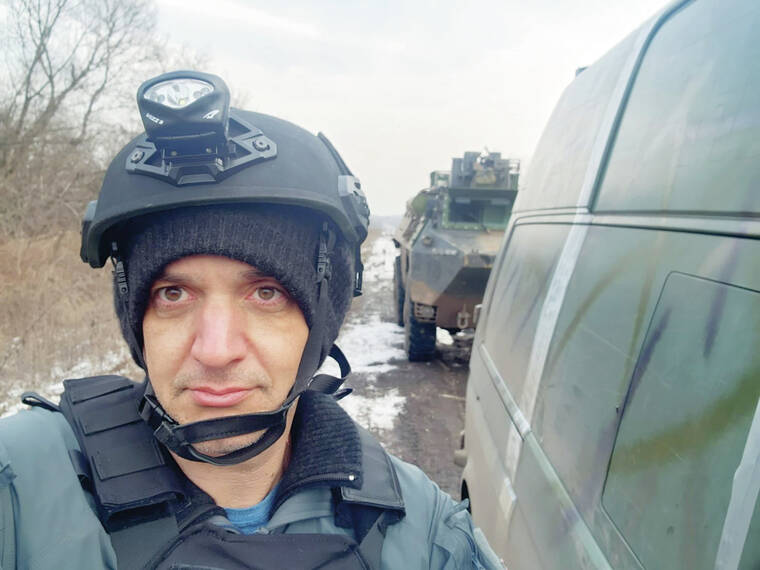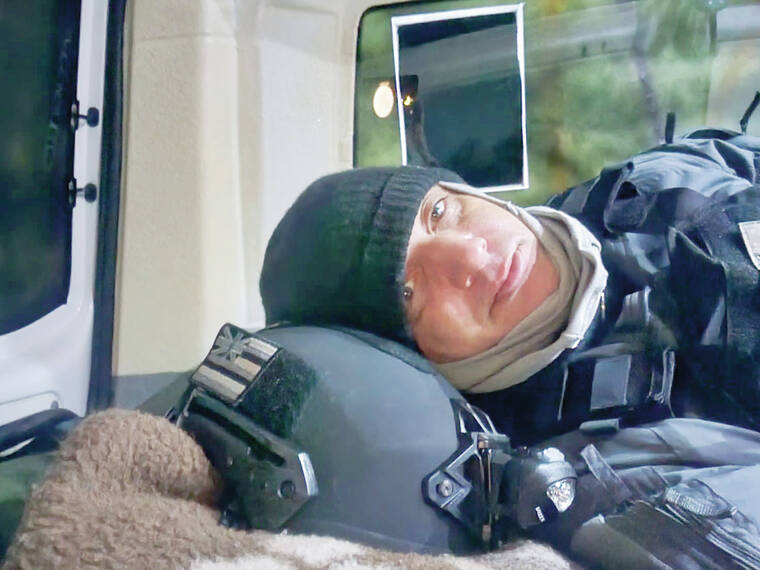SLOVIANSK, Ukraine — Kaua‘i doctor Allon Amitai heard the blast of an air raid siren early Saturday morning.
He was staying at the Old Bridge Hotel in Dnipro — a hub for ex-pats, aid workers and arms dealers — as he made his way to the eastern region of the country to serve as a volunteer medic.
“The front desk clerk wasn’t concerned, since these alerts happen almost every day,” he said. “She should have been more worried.”
That afternoon, Amatai heard a loud explosion — the sound of a Russian Kh-22 antiship missile striking a residential high rise.
The missile demolished an apartment building that once housed 1,700 people. It was the deadliest civilian strike in months, leaving at least 45 dead and 79 injured.
The trip to Sloviansk
On Jan. 9, Amitai began his journey from Kaua‘i to Eastern Ukraine, where he is serving for five weeks as a volunteer with Global Outreach Doctors.
To reach the war zone, he flew from Lihu‘e to Denver, to Munich, to Krakow, Poland, before taking a train to the Polish border city of Przemysl. From there (during a bout of food poisoning) he passed through customs at the Ukrainian border and took an overnight train to Kyiv, then another to Dnipro.
In Dnipro, Amitai met up with his team from Global Outreach Doctors, who, after the apartment strike, drove a borrowed ambulance to the city of Sloviansk, which is close enough to the front line to receive casualties from fighting in Bakhmut and Soledar.
“From here we can hear the rumble of artillery fire, mostly coming from the Ukrainian side,” said Amitai. “No Russian shells have landed nearby and I certainly prefer it that way.”
He is staying at a house rented by Global Outreach Doctors. Drawers and closets are haphazardly piled with possessions of the owners, who seem to have left in a hurry.
A city that held 100,000 people before the invasion, Sloviansk now holds only 20,000. It remains a point of strategic and symbolic importance in the hotly contested Donetsk region. In 2014, it was the first to be taken by the separatists during the previous outbreak of hostilities between Russia and Ukraine, and was only brought back under Ukrainian control after a prolonged siege.
Amitai was surprised at the decentralized nature of the network of foreign volunteers in the area.
“There’s an entire subculture and microeconomy that’s built up around aid organizations, NGOs (nonprofit, non-governmental organizations), and foreign volunteers,” he said.
“There’s a fluid mix of people coming in and out, ranging from seasoned professionals and veterans of other conflicts like Syria and Iraq, to drifters and adventurers, and war tourists and profiteers. Often times they cooperate with each other and network, but sometimes they can compete for contracts to run humanitarian missions.”
According to Amitai, some organizations will arrive with no local contacts or clear purpose and spend weeks or months trying to find a useful role.
“This came as somewhat of a surprise to me,” he said. “But, apparently, it’s not unusual in conflict zones, and there can be legendary ego clashes, with rival contingents of aid groups battling each other for dominance and appropriating supplies and jealously guarding contacts.”
Global Outreach Doctors has been operating in the region for more than six months, and has carved out a niche working with a legion of foreigners serving with the Ukrainian military.
Treating the wounded
Injured soldiers and civilians are initially treated by combat medics before they are rushed to the casualty collection point where Amitai’s team is based.
Most of Amitai’s patients are artillery victims, with lacerations from shrapnel, collapsed lungs and concussions. Some show no visible injuries, but have had their internal organs damaged by a blast wave from an exploding shell.
“I haven’t previously had to deal with blast injury victims, but the basic principles of trauma and medical care are the same,” said Amitai. “Make sure they can breathe, make sure they have blood circulating around their body, stop bleeds, keep their organs working.”
Many combat medics in the region don’t have extensive health care experience, which creates teaching opportunities for Amitai, who has practiced emergency medicine for years. That includes the last eight years at Wilcox Medical Center.
“The first impulse of many Ukrainian medics here is to ‘scoop and run,’ that is, to load the patient into an ambulance and drive as quickly as possible to the fixed trauma stabilization unit 30 minutes away,” said Amitai. “We’ve been trying to encourage and demonstrate thorough assessment and stabilization (first) to ensure that patients can survive the journey.”
On Tuesday, using jury-rigged equipment, Amitai’s team demonstrated the placement of a chest tube for a patient suffering from a life-threatening condition in which a lung collapses and the inside of the chest begins to fill with air. The patient survived the trip to the hospital and is expected to recover.
Amitai described the Ukrainian military as kind and welcoming — “an army of civilians.”
Some are as young as 18 or 19, while others appear to be older than 60. About one-quarter are women.
“They do not take rank or formalities seriously, and many sport meme patches,” he said. “In their downtime, (they) watch Harry Potter videos and take selfies and eat instant noodles and keep pet cats. They are not soldiers by choice.”
•••
Guthrie Scrimgeour, reporter, can be reached at 808-647-0329 or gscrimgeour@thegardenisland.com.







Fascinating and God speed